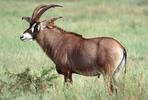
Name
Roan Antelope [Hippotragus equines]Appearance
The body colour is overall fawn, with the lower parts of the legs dark brown to black. The distinctive black and white facial markings are characteristic features of this species. They have long pointed ears. Both sexes have heavily ringed scimitar-shaped horns. Bulls weigh 270 Kg and measures 1.4 m at the shoulder. Cows are smaller and weigh between 170 to 210 Kg. They have long tufted tails.Diet
Roan are primarily grazers, preferring to crop the top portions of grasses, but would occasionally feed on woody and herbaceous plants. They prefer stands of medium to tall grass stands in open savannahs.
Breeding
These antelope do not have a fixed breeding season and calves are born after a gestation period of about 40 weeks. For the first month of its life, the calf is kept hidden among thick bush and when the calves join the herd they group together in creches.
There is a very high mortality rate among Roan antelope calves, up to 80 per cent in the first seven weeks. In the Red Data book, the Roan antelope is listed as an endangered species.
Behaviour
These antelopes are semi-gregarious with the females and the young forming the main herd. There is usually only one bull in each herd and young bachelors form separate groups. In each herd there is a hierarchy, the dominant female in the herd playing the role of matriarch. Roan antelopes are most active during the early hours of the day.
Habitat
They mostly inhabit lightly wooded savannah, open areas of medium sized grass, with easy access to surface water.Where Roan Antelope Are Found
The Roan Antelope is a rare and endangered antelope species, which has a patchy distribution in savannah ecosystems south of the Sahara Desert. Due to past hunting pressures, it now occurs only in areas where rigorous conservation is applied.
In South Africa there are only about 70 in the Kruger National Park, and a total of several hundred in other conservation areas in Mpumalanga and the Northern Province. Population figures for other areas are difficult to obtain.

